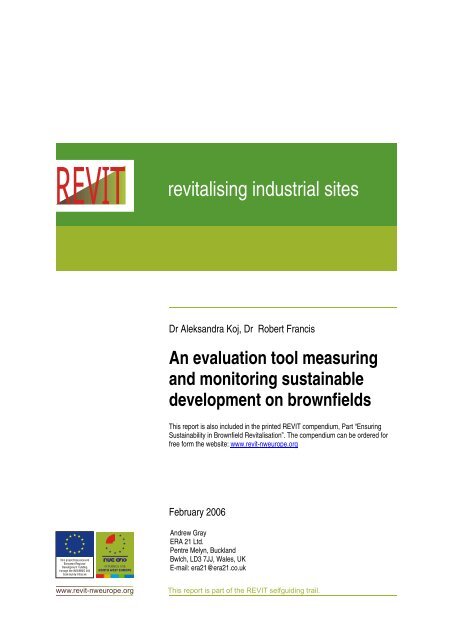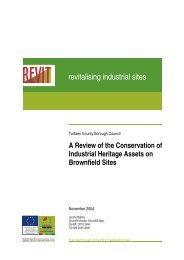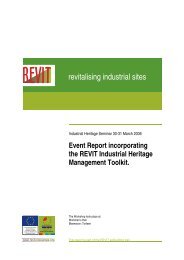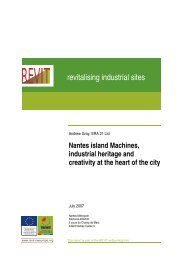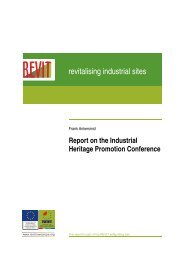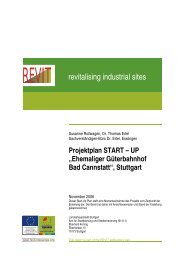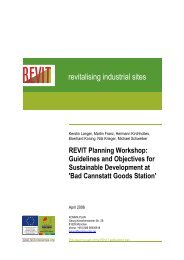REVIT Sustainable Evaluation Tool.pdf
REVIT Sustainable Evaluation Tool.pdf
REVIT Sustainable Evaluation Tool.pdf
You also want an ePaper? Increase the reach of your titles
YUMPU automatically turns print PDFs into web optimized ePapers that Google loves.
<strong>REVIT</strong><br />
revitalising industrial sites<br />
Dr Aleksandra Koj, Dr Robert Francis<br />
An evaluation tool measuring<br />
and monitoring sustainable<br />
development on brownfields<br />
This report is also included in the printed <strong>REVIT</strong> compendium, Part “Ensuring<br />
Sustainability in Brownfield Revitalisation”. The compendium can be ordered for<br />
free form the website: www.revit-nweurope.org<br />
February 2006<br />
Andrew Gray<br />
ERA 21 Ltd.<br />
Pentre Melyn, Buckland<br />
Bwlch, LD3 7JJ, Wales, UK<br />
E-mail: era21@era21.co.uk<br />
www.revit-nweurope.org<br />
This report is part of the <strong>REVIT</strong> selfguiding trail.
<strong>Sustainable</strong> <strong>Evaluation</strong> for Brownfield Sites<br />
Brownfield sites generally have a bad press regarding their status within the realms of urban<br />
development. This is not without foundation. Brownfield sites are often associated with; high<br />
risks of development, including; contaminated land and ground water; structural problems to land<br />
and buildings, high costs of remediation and development; and a poor perception amongst local<br />
stakeholders. If this is not sufficient to quell enthusiasm for renewing Brownfield sites, then the<br />
length of time, planning issues, and funding opportunities for re-use, present further obstacles.<br />
This series of pessimistic outlooks can be viewed alternatively by a more optimistic approach.<br />
This is that Brownfield sites present opportunities to realise sustainable development<br />
improvements and thus they can have a positive impact on the environment, local or regional<br />
economy and the social capital of previously blighted areas.<br />
This positive approach however, requires credible improvements to be made over the long term,<br />
which can be quoted, verified and marketed with confidence. This in turn requires a method of<br />
establishing a sustainable development status baseline together with an evaluation system and a<br />
way of measuring improvements.<br />
Researching, developing and applying a common set of sustainable indicators and an evaluation<br />
process to the development of Brownfield sites has been one of the ambitions of the <strong>REVIT</strong><br />
project. Initial research reviewed the legal and institutional frameworks that set the context for<br />
sustainable development in each partner country, i.e. what are the key drivers and policy issues.<br />
The result of this research showed that it is not possible to develop a common set of sustainable<br />
development indicators and targets for Brownfield sites across the EU. The reason for this is that<br />
each Country and even regions within countries have distinct policies, legislation and approaches<br />
to sustainable development, which may have many common characteristics but also have unique<br />
requirements that cannot be universally applied.<br />
The <strong>REVIT</strong> project has thus developed a methodology that can apply sustainable development<br />
principals to individual sites, through an iterative and integrated approach, where both EU as well<br />
as local targets to improve the status of the environment, economic and social well being are<br />
continually assessed and addressed.<br />
<strong>Sustainable</strong> <strong>Evaluation</strong> Process<br />
The process of sustainability evaluation requires two main elements:<br />
o Sustainability objectives, against which project parameters are weighted and;<br />
o A methodology, which sets targets, measures and shows if, and or how sustainable<br />
development issues have been addressed within a project.<br />
The <strong>Sustainable</strong> <strong>Evaluation</strong> Process developed by the <strong>REVIT</strong> Project shown in fig 1. shows that<br />
at its apex three interconnected elements;- the site, its context and its vision.<br />
2
GENERAL<br />
CONTEXT<br />
SUSTAINABLE<br />
SITE<br />
LOCATION<br />
- Sustainability<br />
Assessment &<br />
Integration<br />
Procedure Selection<br />
- relevant specific<br />
key-data<br />
requirements<br />
PROJECT<br />
VISION<br />
PROJECT<br />
CONTEXT<br />
PROJECT<br />
OBJECTIVES<br />
- EIA<br />
- is SEA required?<br />
- is Master Plan<br />
required?<br />
- do <strong>Sustainable</strong><br />
Building standards<br />
apply?<br />
SUSTAINABILITY ASSESSMENT&INTEGRATION<br />
objectives specific operationalisation<br />
cross-check analysis<br />
prioritisation and objective weighting<br />
evaluation<br />
REVISED SUSTAINABLE PROJECT<br />
OBJECTIVES<br />
PROJECT SCOPE<br />
PROJECT<br />
TARGETS &<br />
INDICATORS<br />
MANAGEMENT<br />
PLAN<br />
AUDIT<br />
3
The first stage requires a full evaluation of these elements in order to provide a firm vision for the<br />
site. Within the general context the following issues should be considered:-i.e.<br />
Qualitative and Quantitative Data, describing the current regional situation in respect of<br />
sustainability issues e.g.:<br />
o environmental<br />
o social<br />
o economic<br />
o institutional<br />
Strategic Planning<br />
o regional/urban development concepts<br />
o regional/urban land use plans<br />
o other documents setting current and future situation of area<br />
The <strong>Sustainable</strong> <strong>Evaluation</strong> Process<br />
The follow framework sets out the sequence and processes to be used to agree sustainable<br />
indicators, set targets and monitor performance:-<br />
Define<br />
the<br />
Vision<br />
Define<br />
Objectives<br />
Define<br />
Scope<br />
Research<br />
Context<br />
Select Level 1<br />
Indicators based on<br />
appropriate scale<br />
Produce a Strategic<br />
Weighting Statement<br />
Audit<br />
System<br />
Set up <strong>Sustainable</strong> Development<br />
Management Plan including<br />
monitoring and reporting<br />
framework<br />
Evaluate, refine, select and agree indicators,<br />
targets and measures<br />
+ Produce a Statement of Targets and<br />
Measures<br />
Step 1<br />
Vision<br />
A clear vision for the Brownfield re-development is essential before any further assessment<br />
and development if sustainable development indicators and targets can continue.<br />
Objectives<br />
A set of clear “SMART” objectives is required in order to focus and agree the scope of the<br />
sustainable development evaluation process.<br />
Scope<br />
The Scope of the project or phase needs to be agreed and stated i.e. is the sustainable<br />
evaluation being undertaken on the whole project or is it for a particular phase i.e. the Master<br />
Plan or reclamation phase or for construction?<br />
Context<br />
It is important that baseline information is available about the site in order to undertake an<br />
evaluation. It is thus also important that all those taking part in the evaluation have prior<br />
access and are fully briefed on this information.<br />
4
Step 2<br />
Choosing a scale appropriate to the development to agree a Strategic Weighting.<br />
To ensure optimum data availability and the cost-effectiveness of the indicators selected to<br />
monitor the project impact, the process suggests that administrative units to be used, are at<br />
the following scales - 1:10,000, (area planning) 1:2,500 (master plans) and 1:500 scales<br />
(buildings and infrastructure). In addition project-specific indicators should be cost effective<br />
in terms of data needs and monitoring requirements.<br />
In order to develop a strategic weighting for the development, e.g. “the sustainable<br />
development bias”, using economic, social and environmental elements, the appropriate<br />
scale of should be chosen to review sustainable development issues based on the present<br />
condition (context) and the opportunities that the development potentially has. On the basis<br />
of this review a strategic weighting can be developed before reviewing in more detail<br />
indicators and measures to set sustainable development targets and measures. It is<br />
suggested that the project Team, and where appropriate key stakeholders, work through this<br />
list and evaluate the indicators as they pertain to the current status of the development<br />
(context) as well as the opportunities perceived to integrate these into to the redevelopment<br />
of a specific Brownfield Site.<br />
Select Indicators on<br />
Scale<br />
Produce Statement<br />
of Strategic Weighting<br />
Determine Strategic<br />
Weighting<br />
Environment - Economy – Social Equity<br />
Step 3<br />
Selection of <strong>Sustainable</strong> Development Indicators and Targets<br />
Each project should have an agreed set of sustainable development indicators and targets.<br />
These can be chosen by using a number of methods to agree the targets and measures<br />
appropriate for the site but as a minimum the team should;<br />
consider how the project/strategy contributes to each objective, and reach a<br />
consensus<br />
identify “key issues” and suggest solutions<br />
Use the following scale when considering the compatibility of the proposed<br />
activity with the objectives:<br />
U<br />
P<br />
N<br />
F<br />
G<br />
E<br />
Undermining - significantly undermines the objective<br />
Poor - does not fully explore the potential to contribute to the objective<br />
Neutral - does not contribute to the objective<br />
Fair - makes some direct or significant indirect contribution<br />
Good - makes a significant positive contribution<br />
Excellent - makes a close to optimal contribution to the objective<br />
5
Regarding the methodology of sustainability measurement, two examples are cited:<br />
1. Methodology for Sustainability Integration and Appraisal developed by the Welsh<br />
Development Agency(WDA). The process of sustainable integration in this document is<br />
introduced as a more positive and realistic approach. This means:<br />
“finding ways of pursuing each objective with the minimum of harm to others, and where<br />
choices between objectives are inevitable, to be explicit and democratic about the<br />
choices”<br />
The process can also be defined as “Conflict Minimisation” – finding solutions which<br />
reduce (but not necessarily fully overcome) conflicts between different objectives. When<br />
key conflicts are identified, these are treated as a “Crunch Issue”, and ways of reducing<br />
or resolving them are searched for and agreed”.<br />
2. An alternative option to the methodology provided by the WDA is the tool for<br />
sustainability assessment developed by the RESCUE project team. The purpose of the<br />
RESCUE—Sustainability Assessment <strong>Tool</strong> (SAT) is to provide a methodology which<br />
considers sustainability criteria from a local and regional context perspective together<br />
with conflicting priorities to assess future brownfield regeneration projects in terms of site<br />
/ local specific sustainability. This approach provides support for funding and / or<br />
permission decisions. A full description of the SAT is available: www.rescueeuropa.com<br />
The process of agreeing on the sustainable objectives of a site has to be based on agreements<br />
achieved through discussion between institutional and non-institutional stakeholders affected by<br />
the project. The depth of participatory approach depends in reality on conditions such as owner<br />
attitude, scale of project and quality and level of local governance culture.<br />
To be sure that stakeholders participation will bring desired outcomes, the process has to be<br />
professionally designed and integrated with other project activities from earliest stages and<br />
adjusted to local conditions.<br />
To design and implement a process of stakeholder engagement it is advised to use professional<br />
guides and manuals providing theoretical overview of the topic together with practical indications<br />
regarding optimal project-specific conditions methods and tools. For example A <strong>Tool</strong> Kit for<br />
Stakeholder Engagement prepared by the <strong>REVIT</strong> project.<br />
This process of agreeing the sustainable objectives of a site may require a revision to the original<br />
objectives and in some cases altering or changing the vision for the site. The proposed process<br />
allows for cycles of changes to take place on an iterative basis. Once the objectives have been<br />
agreed then the appropriate tools and targets, indicators and measuring techniques can be<br />
selected. This in turn leads to a management plan to control this process throughout the duration<br />
of the project, reporting, variances to agreed tolerances, verifying compliance and reporting<br />
results. Finally an audit process will ensure that the results are verifiable and the sustainable<br />
benefits of the project are credible as well as ensuring that the project plan aims and objectives<br />
have been met.<br />
Produce Statement of Targets and Measures<br />
6
Step 4<br />
A sustainable development management plan with a monitoring and reporting framework<br />
should be created, based on the selected and agreed indicators, targets and measures.<br />
Produce a <strong>Sustainable</strong> Development<br />
Management Plan + Monitoring and Reporting<br />
Process<br />
Step 5<br />
An audit checklist and system must be set up to review how well the sustainable<br />
development targets and outcomes are being met during as well as after the development is<br />
completed.<br />
Produce Audit and Review Report<br />
<strong>Tool</strong>s for <strong>Sustainable</strong> <strong>Evaluation</strong><br />
A set of checklists have been developed by the <strong>REVIT</strong> Project to assist with evaluating<br />
<strong>Sustainable</strong> Development issues on brownfield sites.<br />
The 5 Minute <strong>Sustainable</strong> Development Brownfield Site Check List<br />
Has a Cost Benefit Analysis (CBA) been undertaken?<br />
Has a Multi-Criteria Assessment (MCA) been undertaken?<br />
Has Life Cycle Costing (LCC) been undertaken?<br />
Has a Life Cycle Analysis (LCA) been completed?<br />
Has Environmental Impact Assessment been completed?<br />
Has Heritage Impact Assessment been completed?<br />
Do the Strategic Environmental Assessment requirements apply?<br />
Do Environmental Building standards apply?<br />
Has a strategy of stakeholders engagement been developed?<br />
Has a strategy for site marketing been drawn up?<br />
Has a strategic sustainable development weighting been undertaken?<br />
Has a sustainable development management plan been completed<br />
Has an environmental audit been completed?<br />
Have financial costs and risks been assessed<br />
Strategy/programme<br />
Masterplan<br />
Single site<br />
Cluster of sites<br />
Regeneration/redevelopment<br />
Check List to Identify Type of Project<br />
7
New development<br />
Urban area<br />
Rural area<br />
Mix-type area<br />
other ………………………………………………………<br />
Check List to Identify Stage of project<br />
Initiating phase<br />
Characterisation phase<br />
Planning/design phase<br />
Preparation of project implementation phase<br />
Implementation phase<br />
Closure phase<br />
Check List to Identify Polices and Strategic Documents Relevant to the Project<br />
Regional Development Strategy<br />
Area regeneration strategy<br />
Economic strategy<br />
Landscape strategy<br />
Community development strategy/plan<br />
Regeneration masterplan<br />
Area action plans<br />
Waste Framework Directive<br />
SEA Directive<br />
EIA Directive<br />
Other……………………………………………..<br />
Conclusions<br />
A common set of sustainable indicators and an evaluation process to the development of<br />
Brownfield sites at an EU or even National level is not practical or possible. What is important is<br />
that sustainable development issues are integrated into Brownfield projects from the start. This<br />
requires an explicit set of aims and objectives to be agreed as to how each Brownfield site is<br />
expected to respond to the sustainable development agenda. A key question to be determined at<br />
the outset is the weighting of a new project based on its potential bias towards the environment,<br />
economic growth or social improvements. Each of these or a mix thereof will present different<br />
sets of indicators, targets and aims for a project to attain a unique status of sustainable<br />
development.<br />
The <strong>REVIT</strong> sustainable evaluation process allows for the respect of individual circumstances<br />
related to Brownfield sites and their proposed development as well as providing for an iterative<br />
approach required to respond to changes that inevitable occur during long term and complex<br />
projects.<br />
8


